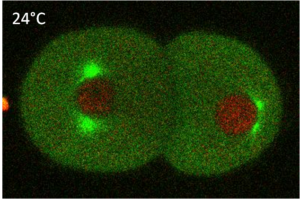C. elegans as a major model organism in biology ?
Since C. elegans starts to be used as a model organism more than 20.000 publications covering a wide range of topics in biology were published and 5 Nobel Prizes involves the worm: S. Brenner, J. Sulston, R. Horvitz, M. Chalfie and CC Mello. This microorganism was once name: the “Nature’s gift to science” by Sydney Brenner who focus his research, in the early 60’s, into the area of neuronal development using this transparent nematode. In the middle 70’s he even followed studying on C. elegans but from the molecular and biology development point of view(1).
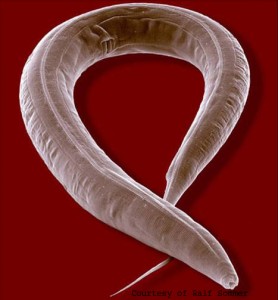
C. elegans as a simple laboratory model?
C. elegans gender is Caenorhabditis, it belongs to the family of the Rhabditidae. This roundworm formed of only 1000 cells and this was the reason why it was the first animal that had its genome completely sequenced back in 1998(2). This achievement leaded to follow the genome sequencing race that ended with the Human Genome Project(3). C. elegans wiring diagram or so-called “connectome” had been realized in 2012(4,5). This major advanced leads to a rapid debate inside the community : does a simplified model (neuronal connection network of C. elegans) can explain the behavior of a complex living organism?
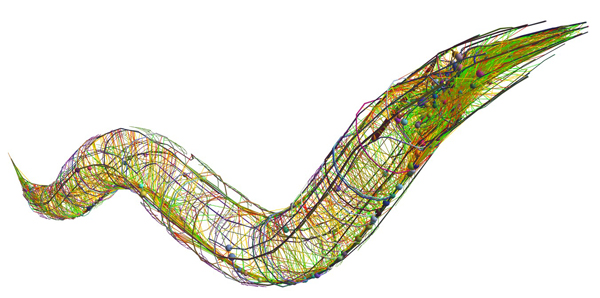
This nematode is the best candidates for adaptation to environment with a noticeable consequence on its physiology: C. elegans lifespan is depending on the environment. (8)As mentioned by Frézal L back et al. in 2015 (6), C. elegans has been considered as a top model organism for research in biology for decades. C. elegans is very easy to grow it on a Petri dish and only two incubators are needed, one at 15°C and another one at 25°C. Then the growing time is very fast, around 56 hours(7) and it is possible to have multiple worms on a single Petri dish.
Temperature has major impacts on C. elegans life cycle
If the environment is not stable enough during the first two stages a “Dauer” additional developmental stage appears. (10) It is considered as a dormant phase where the worm can survive up to four months which is a drastic increase of their normal lifespan (around 3 weeks). This occurs due to two genes called daf-2 and daf-23(11) that with their expression they allow the normal growing cycle. When they are not presented the nematode turns to “Dauer” stage. Temperature has a major impact on C. elegans development. First of all the growth development is related to temperature because they are sensitive to it.(9) This transparent nematode has 4 larval stages that go from L1 to L4 and one mature or adult stage. The length of each cycle is temperature dependant. As an example if the embryos are grown at 15°C they will reach the mature stage in 6 days but if the temperature is increased by 10°C to 25°C, this time is reduced to more than the half, so they can become adult worms in 2.5 days.
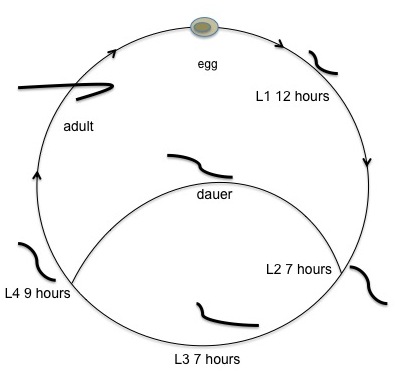
How temperature affects C. elegans aging?
If C. elegans is grown in a liquid environment at 16°C the lifespan is of 23 days. If the temperature is set to 25°C, the lifespan gets reduced to 9 days. This difference can only be explained by mentioning the role of clock genes (Clk). These are genes controlling the circadian rhythms, cycles of genes expression or behaviors that repeat more or less every 24 hours. Those cycles represent an internal clock that can be synchronized due to external stimulus that in the case of C. elegans are related with light/dark and temperature. (12,13) The key here would be to understand the relationship between those clock genes and the capability of the temperature to control their expression. It has to be mentioned that the wild worms can adjust their own lifespan according to the surrounding temperature but the mutants lacking of the Clk gene cannot respond to it.
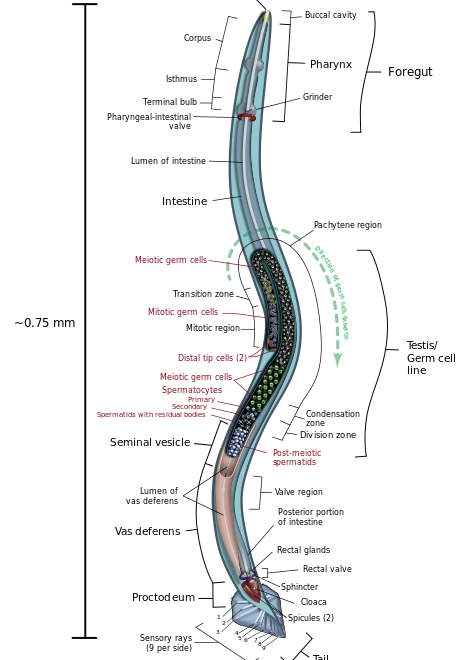
How C. elegans temperature-sensitive mutants are used?
Although still possible with traditional techniques (random mutagenesis), it is now easier than ever to create thermo-sensitive nematodes thanks to the development of DNA engineering techniques such as TALEN or CRISPR/Cas9 (14),
A lot of temperature-sensitive C. elegans worms have been used to study the genes that act on the growth and development (15) This study shows ways to avoid the lethal effect of zygotic, maternal effects or sterile mutations. This research team identified 24 thermo-sensitive alles of a group of 13 genes. Some of them like the mex-1 mutation have direct effects on the embryo polarity development.
Temperature-sensitive mutants and wild type C. elegans are a great field of study in biology.
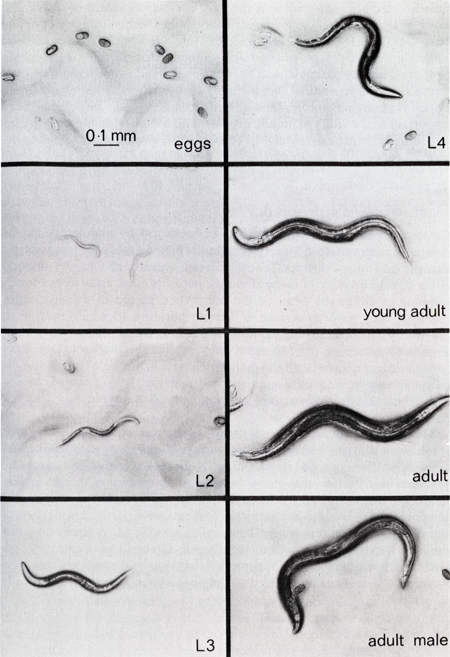
How to use temperature-control to study C. elegans neuronal lineage?
There are some neurologic diseases such as ALS, Parkinson or Huntington that have been studied in C. elegans.For ALS and Huntington temperature-sensitive mutant genes can work as modifiers for the misfolding of proteins and for toxicity aggregation. This gives the possibility to combine live-cell imaging with fast temperature shifts that go from permissive to restrictive temperatures. Thanks to fast temperature shift it is possible to watch GFP-tagged mutant protein aggregation. (16,17)
How could you achieve the temperature-shifts necessary to publish your paper ?
It is crucial to thermalize correctly when working with C. elegans and scientists used to incubate the worms at the target temperature. Incubation is good for long term experiments, we may wonder how to make fast temperature changes and live-cell imaging. How to create the best set up in term oftemperature control with C. elegans to be able to published articles with the most accurate methods?
We designed CherryTemp, the world’s fastest heater-cooler for microscopy that allows you to make temperatures changes in the range of 5°C to 45°C in 10 seconds and at the same time get microscope images. All the studies mentioned before could be done using CherryTemp because it allows both thermalization and live-cell imaging.
CherryTemp is robust, stable and very easy to use, it fits within any microscope settings and we provide assistance to help you and individual meeting if needed.
Ultra fast temperature shift device for in vitro experiments under microscopy
References
- Brenner S. The genetics of Caenorhabditis elegans. Genetics. 1974;77(1):71–94.
- Hodgkin J. C. elegans: Sequence to Biology. Science (80- ). 1998;282(5396):2011–2011.
- Venter JC, Adams MD, Myers EW, Li PW, Mural RJ, Sutton GG, et al. The Sequence of the Human Genome. 2001;291(February).
- Towlson EK, Vertes PE, Ahnert SE, Schafer WR, Bullmore ET. The Rich Club of the C. elegans Neuronal Connectome. J Neurosci [Internet]. 2013;33(15):6380–7.
- Jarrell TA, Wang Y, Bloniarz AE, Brittin CA, Xu M, Thomson JN, et al. The Connectome of a Decision-Making Neural Network. Science (80- ). 2012;337(July):437–44.
- Frézal L, Félix MA. C. elegans outside the Petri dish. Elife [Internet]. 2015 [cited 2016 Sep 23];2015(4).
- Allen EN, Ren J, Zhang Y, Alcedo J. Sensory systems: Their impact on C. elegans survival. Vol. 296, Neuroscience. Elsevier Ltd; 2015. p. 15–25.
- O’Rourke SM, Carter C, Carter L, Christensen SN, Jones MP, Nash B, et al. A survey of new temperature-sensitive, embryonic-lethal mutations in C. elegans: 24 alleles of thirteen genes. PLoS One. 2011;6(3).
- Karp X. Working with dauer larvae. WormBook [Internet]. 2016 Jul 14 [cited 2016 Sep 23];1–19.
- Gottlieb S, Ruvkun G. daf-2, daf-16 and daf-23: Genetically interacting genes controlling dauer formation in Caenorhabditis elegans. Genetics. 1994;137(1):107–20.
- Jones R. Day and Night: Circadian Rhythms in Worms. PLoS Biol [Internet]. 2010 Oct 12 [cited 2016 Sep 27];8(10):e1000511.
- van der Linden AM, Beverly M, Kadener S, Rodriguez J, Wasserman S, Rosbash M, et al. Genome-Wide Analysis of Light- and Temperature-Entrained Circadian Transcripts in Caenorhabditis elegans. Schibler U, editor. PLoS Biol [Internet]. 2010 Oct 12 [cited 2016 Sep 27];8(10):e1000503.
- Hsu P, Lander E, Zhang F. Development and applications of CRISPR-Cas9 for genome engineering. Cell [Internet]. 2014 [cited 2016 Sep 27];
- Davies T, Sundaramoorthy S, Jordan S. Using fast-acting temperature-sensitive mutants to study cell division in Caenorhabditis elegans. Methods Cell [Internet]. 2016 [cited 2016 Sep 27];
- O’Rourke S, Carter C, Carter L, Christensen S. A survey of new temperature-sensitive, embryonic-lethal mutations in C. elegans: 24 alleles of thirteen genes. PLoS [Internet]. 2011 [cited 2016 Sep 27];
- Vilariño-Güell C, Rajput A, Milnerwood A. DNAJC13 mutations in Parkinson disease. Hum Mol [Internet]. 2014 [cited 2016 Sep 27];
- Rodriguez M, Snoek L, Bono M De, Kammenga J. Worms under stress: C. elegans stress response and its relevance to complex human disease and aging. Trends Genet [Internet]. 2013 [cited 2016 Sep 27];
- Marder E, Bucher D. Understanding Circuit Dynamics Using the Stomatogastric Nervous System of Lobsters and Crabs. Annu Rev Physiol [Internet]. 2007 Mar [cited 2016 Sep 28];69(1):291–316.
- P granules function in germ line formation of Caenorhabditis elegans [Internet].
FAQ
C. elegans has been used as a model organism for decades, beginning with research in the early 1960s into neuronal development. It has been the subject of over 20,000 publications, and research involving this nematode has been associated with five Nobel Prizes. The organism is considered simple, being formed of only 1000 cells. This simplicity is one reason it was the first animal to have its genome completely sequenced. Its neuronal connection network, or "connectome," has also been realised. In the laboratory, C. elegans is very easy to grow on a Petri dish, requiring only two incubators set at 15°C and 25°C. The growing time is also fast, at around 56 hours.
Temperature has a pronounced effect on the development of C. elegans. The organism’s growth development is sensitive to temperature. The life cycle includes four larval stages, L1 to L4, followed by a mature adult stage. The length of each of these cycles is dependent on the temperature. This dependency is quite clear. If embryos are grown at 15°C, they will reach the mature adult stage in six days. If the temperature is increased by 10°C to 25°C, this time is reduced by more than half. At the warmer temperature, they can become adult worms in just 2.5 days.
The "Dauer" stage is an additional developmental stage for the nematode. It is considered a dormant phase. This stage appears if the environment is not stable enough during the first two larval stages. During this dormant phase, the worm can survive for up to four months. This is a large increase compared to its normal lifespan of about three weeks. The appearance of this stage is related to the function of two genes, daf-2 and daf-23. When these genes are expressed, they permit the normal growing cycle to proceed. If they are not present, the nematode turns to the "Dauer" stage instead.
The lifespan of C. elegans is dependent on its environment. Temperature is a specific condition that influences aging. When grown in a liquid environment at 16°C, the worm’s lifespan is 23 days. If the temperature is set to 25°C, this lifespan gets reduced to only 9 days. This difference is explained by the function of clock genes, or Clk. These genes control circadian rhythms, which are cycles of gene expression or behaviours that repeat approximately every 24 hours. These cycles represent an internal clock. This clock can be synchronised by external stimuli, which for C. elegans, are related to light/dark and temperature. Wild worms can adjust their lifespan according to the temperature, but mutant worms lacking the Clk gene cannot respond to it.
Temperature-sensitive C. elegans worms are used to study the genes that act on growth and development. Using these mutants provides a way to avoid the lethal effect of certain zygotic or maternal effect mutations. One study identified 24 thermo-sensitive alleles for 13 different genes. A mutation like mex-1 was found to have direct effects on the development of embryo polarity. These mutants are also used to study some neurologic diseases, such as ALS and Huntington. For these conditions, temperature-sensitive mutant genes can work as modifiers for protein misfolding and for toxicity aggregation. This application gives the possibility to combine live-cell imaging with fast temperature shifts, watching GFP-tagged mutant protein aggregation as the temperature is changed from permissive to restrictive.


